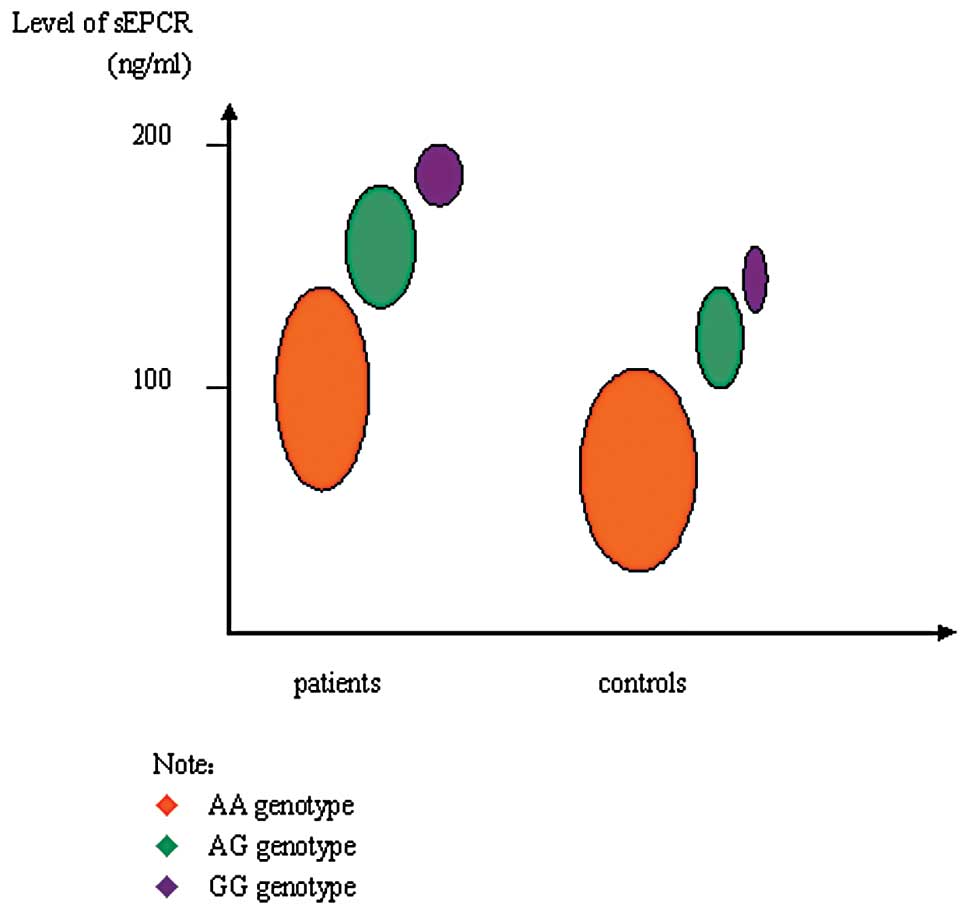|
1.
|
Davies KA, Ireland H, Athanassiou P,
Loizou S, Lane D and Walport MJ: Factor V Leiden mutation and
venous thrombosis. Lancet. 345:132–133. 1995. View Article : Google Scholar : PubMed/NCBI
|
|
2.
|
Laposata M: The prothrombin G20210A
mutation: a new high-prevalence congenital risk factor for
thrombosis. Gastroenterology. 116:213–215. 1999. View Article : Google Scholar : PubMed/NCBI
|
|
3.
|
Seligsohn U and Lubetsky A: Genetic
susceptibility to venous thrombosis. N Engl J Med. 344:1222–1231.
2001. View Article : Google Scholar : PubMed/NCBI
|
|
4.
|
Frosst P, Blom HJ, Milos R, et al: A
candidate genetic risk factor for vascular disease: a common
mutation in methylenetetrahydrofolate reductase. Nat Genet.
10:111–113. 1995. View Article : Google Scholar : PubMed/NCBI
|
|
5.
|
Stearns-Kurosawa DJ, Kurosawa S, Mollica
JS, Ferrell GL and Esmon CT: The endothelial cell protein C
receptor augments protein C activation by the
thrombin-thrombomodulin complex. Proc Natl Acad Sci USA.
93:10212–10216. 1996. View Article : Google Scholar : PubMed/NCBI
|
|
6.
|
Centelles MN, Puy C, López-Sagaseta J,
Fukudome K, Montes R and Hermida J: Blocking endothelial protein C
receptor (EPCR) accelerates thrombus development in vivo. Thromb
Haemost. 103:1239–1244. 2010. View Article : Google Scholar : PubMed/NCBI
|
|
7.
|
Ridker PM: Inherited risk factors for
venous thromboembolism: implications for clinical practice. Clin
Cornerstone. 4:18–30. 2002. View Article : Google Scholar : PubMed/NCBI
|
|
8.
|
Koster T, Rosendaal FR, Briët E, et al:
Protein C deficiency in a controlled series of unselected
outpatients: an infrequent but clear risk factor for venous
thrombosis (Leiden Thrombophilia Study). Blood. 85:2756–2761.
1995.
|
|
9.
|
Fukudome K and Esmon CT: Identification,
cloning and regulation of a novel endothelial cell protein
C/activated protein C receptor. J Biol Chem. 269:26486–26491.
1994.PubMed/NCBI
|
|
10.
|
Gu JM, Katsuura Y, Ferrell GL, Grammas P
and Esmon CT: Endotoxin and thrombin elevate rodent endothelial
cell protein C receptor mRNA levels and increase receptor shedding
in vivo. Blood. 95:1687–1693. 2000.PubMed/NCBI
|
|
11.
|
Kurosawa S, Stearns-Kurosawa DJ, Carson
CW, D'Angelo A, Della Valle P and Esmon CT: Plasma levels of
endothelial cell protein C receptor are elevated in patients with
sepsis and systemic lupus erythematosus: lack of correlation with
thrombomodulin suggests involvement of different pathological
processes. Blood. 91:725–727. 1998.
|
|
12.
|
Espana F, Vaya A, Mira Y, et al: Low level
of circulating activated protein C is a risk factor for venous
thromboembolism. Thromb Haemost. 86:1368–1373. 2001.PubMed/NCBI
|
|
13.
|
Navarro S, Medina P, Mira Y, et al:
Haplotypes of the EPCR gene, prothrombin levels, and the risk of
venous thrombosis in carriers of the prothrombin G20210A mutation.
Haematologica. 93:885–891. 2008. View Article : Google Scholar : PubMed/NCBI
|
|
14.
|
Zöller B: Familial thrombophilia: clinical
and molecular analysis of Swedish families with inherited
resistance to activated protein C or protein S deficiency. Scand J
Clin Lab Invest Suppl. 226:19–46. 1996.PubMed/NCBI
|
|
15.
|
Villoutreix BO, Blom AM and Dahlbäck B:
Structural prediction and analysis of endothelial cell protein
C/activated protein C receptor. Protein Eng. 12:833–840. 1999.
View Article : Google Scholar : PubMed/NCBI
|
|
16.
|
Saposnik B, Reny JL, Gausem P, Emmerich J,
Aiach M and Gandrille S: A haplotype of the EPCR gene is associated
with increased plasma levels of sEPCR and is a candidate risk
factor for thrombosis. Blood. 103:1311–1318. 2004. View Article : Google Scholar : PubMed/NCBI
|
|
17.
|
Yamagishi K, Cushman M, Heckbert SR, Tsai
MY and Folsom AR: Lack of association of soluble endothelial
protein C receptor and PROCR 6936A/G polymorphism with the risk of
venous thromboembolism in a prospective study. Br J Haematol.
145:221–226. 2009. View Article : Google Scholar : PubMed/NCBI
|











